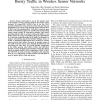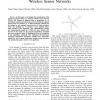CISIS
2009
IEEE
13 years 9 months ago
2009
IEEE
The following paper deals with criterion used to measure communication protocol efficiency in Wireless Sensor Networks. As energy is a crucial characteristic of those networks, it...
SIGSOFT
2010
ACM
13 years 9 months ago
2010
ACM
The development of wireless sensor networks (WSNs) software today is tackled by a code-and-fix process that relies solely on the primitive constructs provided by the operating sys...
SENSYS
2010
ACM
13 years 9 months ago
2010
ACM
Wireless sensor networks (WSNs) are hard to program due to unconventional programming models used to satisfy stringent resource constraints. The common event-driven concurrent pro...
SECON
2010
IEEE
13 years 9 months ago
2010
IEEE
Abstract--This paper considers the novel area of quality-ofinformation (QoI)-aware network management of multitasking wireless sensor networks (WSNs). Specifically, it provides an ...
MOBILIGHT
2010
13 years 9 months ago
2010
This paper investigates the INTERSECTION Framework's ability to build resilience into Wireless Sensor Networks. The framework's general details are examined along with ge...
MASS
2010
13 years 9 months ago
2010
In this paper we describe SpartanRPC, a secure middleware technology for wireless sensor network (WSN) applications supporting cooperation between distinct protection domains. The ...
MASS
2010
13 years 9 months ago
2010
Clustering and data aggregation in wireless sensor networks improves scalability, and helps the efficient use of scarce resources. Yet, these mechanisms also introduce some securi...
GLOBECOM
2010
IEEE
13 years 9 months ago
2010
IEEE
Energy conservation is one of the primary goals of the majority of MAC protocols designed for wireless sensor networks. In Sensor-MAC (S-MAC), one of the first MAC protocols design...
GLOBECOM
2010
IEEE
13 years 9 months ago
2010
IEEE
We study the energy consumption of individual links in wireless sensor networks (WSN). Three widely used digital modulation schemes, i.e. MQAM, MPSK, and MFSK, are analyzed and com...
GLOBECOM
2010
IEEE
13 years 9 months ago
2010
IEEE
In this paper, we investigate the maximization of the amount of gathered data in a clustered wireless sensor network (WSN). The amount of gathered data is maximized by (1) choosing...


